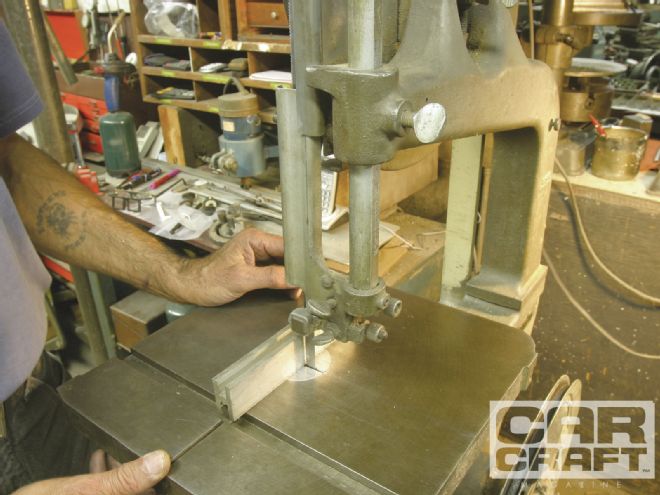
The beauty of this column is that we’re not limited to stories emanating from automotive boneyards. If there’s a cheap way to convert something like an inexpensive, wood-cutting bandsaw into a pricey metal bandsaw, we will print it here. And that’s exactly what our machinist pal Lucki Candoff did many years ago when he got a great deal on a wood bandsaw. The problem with wood saws is that they spin too fast, typically with blade speeds of 600 to 2,600 feet per minute (fpm). Cutting metal demands much slower speeds, so a metal bandsaw spins around 100 to 300 fpm. Since Candoff is a machinist, it wasn’t much trouble for him to work out a speed reduction solution by adding a second set of pulleys and convert his wood cutting bandsaw to a metal bandsaw.
Perhaps the most difficult part of this conversion is working out the proper blade speed reduction. Reducing the pulley speed demands a second set of pulleys. This requires placing an independent jackshaft between the first set that will mount a second small pulley to drive the larger pulley to again reduce the speed. It sounds complicated, but it’s actually pretty simple. Candoff’s Rockwell wood saw uses one pair of pulleys to connect the electric motor to a second set of the 1:1 pulleys used for the blade. Since the second set of pulleys had no adjustment for belt tension, Candoff added a third small pulley on an adjustable slide to be used as a tensioner. As far as building the system, Candoff says the hardest part was cutting the saw’s base to open up enough area to allow placement of the second large pulley. Fitting everything to line up properly also required a little forethought. Here’s how he did it.
Here’s how the math works out on the underdrive ratios. This system is set up much like an accessory drive on your engine. Think of each drive pulley as a small crank pulley and the driven pulley as the larger-alternator pulley intended to slow the speed of the alternator. A smaller-drive pulley reduces overall speed.
Primary Pulley System Secondary Pulley System Drive pulley diameter: 2 inches Drive pulley diameter: 3.5 Driven pulley diameter: 12 inches Driven pulley diameter: 13.5 Primary underdrive ratio: 6:1 Secondary underdrive ratio: 3.85:1 Motor speed: 1,800 rpm Motor speed: 300 rpm Primary driven pulley shaft speed: 1,800 / 6 = 300 rpm Secondary driven pulley shaft speed: 300 / 3.85:1 = 78 rpm
We also measured the diameter of the pulley that drives the blade. This allows us to calculate the actual blade speed. The math is easy: Merely multiply the shaft speed by the pulley diameter by pi. With both wheel diameters at 13.75 inches and an input shaft speed of 78 rpm, we used this formula:
78 x 13.75 x 3.1417 (pi) = 3,369 inches per minute of belt speed
To convert to feet per minute: 3,369 / 12 = 280 fpm
When cutting metal, you have several options that will affect both the speed and quality of the cut. Both blade material and teeth-per-inch (TPI) are critical variables. We found this chart on SupercutBandsaw.com. The Raker refers to a specific style of blade, and the company recommends between 2 and 10 teeth in contact with the material at all times. Fewer TPI is for thicker materials, while thinner metals will cut better with more TPI. While carbon tool steel blades are the least expensive, the costlier bimetal blades last much longer, especially if lubricants are used when cutting thick material. End
Carbon Tool Steel(TPI) Material Thickness(Inches) Bimetal 24 Raker 1⁄16-1⁄4 20-24 18 Raker 1⁄8-3⁄8 14-18 14 Raker 3⁄16-7⁄16 10-14 10 Raker 1⁄4-1⁄2 8-12